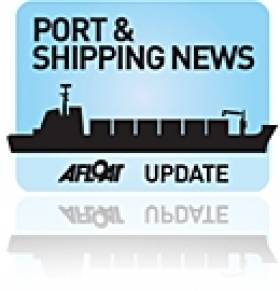Displaying items by tag: IMDO results Q3
Container Shipping Volumes Rose 9% in Q3 2014
#ContainerRiseVolume – According to the Irish Maritime Development Office (IMDO) container shipping volumes, Lo/Lo have rose by 9% in Q3 of 2014.
Ro/Ro experienced a 6% growth and Break Bulk volumes grew by 16%. This is in contrast however to total traffic volumes through Irish ports which fell by 3% overall in Q3, when compared to the same period last year. This decline is captured in the iShip index which fell to 818 points in the period under review. The reduction in total volumes is attributable to the Dry Bulk and Liquids sectors and in particular to lower trade volumes in commodities such as coal, oil and fertilizer.
Activity in the Dry Bulk market generally dips in Q3, however, the decrease this year was more pronounced with volumes dropping to 3,290,393 tonnes, their lowest level since Q3 2012. A decline in coal imports was the largest contributory factor to the drop in the Dry Bulk volumes, while Liquid Bulk volumes fell by 16%, largely as a result of reduced oil imports. The markets for commodities such as coal and oil were influenced by mild weather conditions.
For the sixth quarter in a row the Ro/Ro sector has grown (up 6% on Q3 last year). Furthermore, Lo/Lo volumes increased 9% in Q3, the highest quarterly growth rate recorded in this traffic mode since 2007. As the majority of consumer goods are transported on Ro/Ro and Lo/Lo services, increases in traffic volumes on these modes support findings of improved consumer sentiment in the Irish economy. In September 2014, the KBC Ireland/ESRI Consumer Sentiment Index rose to 92.8, its highest level since January 2007.
In the Lo/Lo sector, laden imports rose by 13% in Q3, buoyed by a marked increase in demand for consumer goods from the Far East.
Ro/Ro freight volumes increased by 6% to 239,380 units in Q3, with 86% of this volume moving on services between Ireland and Great Britain. Ro/Ro traffic on direct services to the continent has been sluggish for the first three quarters of 2014, with a year on year growth of less than 1% recorded.
Break Bulk, which largely consists of imports of construction and project related materials, increased by 16%. Break Bulk has now seen five consecutive quarterly increases, supporting the view that the construction industry is experiencing sustained growth, albeit from a low base.
For a summary of freight traffic trends for the Republic of Ireland (see graph) and for more information and the role of the IMDO, visit their website HERE.





























































